
Cimicifuga: planting, growing and caring for
Contents
Cimicifuga, in a nutshell
- Cimicifugas are perennials that thrive in shade or partial shade, ideal for brightening a dark corner of the garden.
- They flower at a time of year when flowers are scarcer: from summer to first frosts.
- Flowers consist of elegant, architectural, fragrant and striking flower spikes that float above a clump of foliage.
- Different varieties of Cimicifuga can dress the back of borders with a range of heights and colours.
A word from our expert
Very easy to grow, le cimicifuga (or Actaea) is a hardy perennial notable in the garden for its elegant, airy flowering stems that rise above its foliage. These graceful stems end in white to pink flower spikes that will brighten shady corners. They are, in fact, the origin of its other common name, the silver candle. They can reach up to 1.8 metres in height, ideal for adding an airy touch to back of a border.
Best placed in shade or partial shade, cimicifuga flowers from late spring to first autumn frosts, a time of year when flowers become scarcer. In addition, some varieties are fragrant and evoke the sweetness of vanilla.
Cimicifuga, also called Actaea, prefers humus-bearing, neutral, cool to even moist media. It suits both landscaped gardens and contemporary gardens.
Best known species such as Cimicifuga racemosa or Actaea simplex have green deciduous foliage, but there are varieties with bluish, purple or violet-to-brown deciduous foliage. Some even produce decorative white berries. So all that’s left is to make your choice!
Description and botany
Botanical data
- Latin name Cimicifuga or Actaea
- Family Ranunculaceae
- Common name silver candle, bugbane, black cohosh
- Flowering summer to autumn
- Height 60 cm to 1.80 m
- Sun exposure partial shade to shade
- Soil type clayey, rich and fresh, neutral to slightly acidic or alkaline.
- Hardiness at least down to -15°C
Cimicifugas are hardy perennials of Ranunculaceae family like anemones. Native to temperate zones of Northern Hemisphere, there are about thirty different species in Europe, Asia and North America. They are shade or partial-shade plants that like rich, fresh or moist mediums. They also prefer clayey soils neutral to slightly acidic or alkaline.
The word Cimicifuga comes from Latin contraction of cimex meaning “bug” and fugare meaning “to flee”. This name would come from unpleasant odour of its flowers, which would drive away that insect. It even seems that the most common species, Cimicifuga racemosa, may have insecticidal properties, repelling mosquitoes and other small insects.
The genus Cimicifuga and genus Actaea were formerly separated into two distinct genera. The first produces dry follicles while genus Actaea forms berries. Today this classification has evolved and genera have been merged by most botanists. Thus species can be found indifferently under either genus name, such as Actaea racemosa or Cimicifuga racemosa, called black cohosh. In France this latter is the most cultivated species of the genus. In second place stands Actaea simplex, very widespread for its variety Brunette with purplish-brown foliage.
Cimicifugas are known under many names such as actaea, bugbane, silver candle, bug herb or St Christopher’s herb.
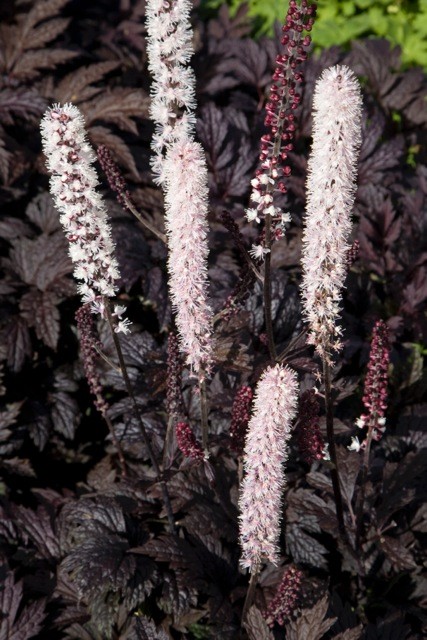
Cimicifuga with beautiful chocolate foliage
Cimicifugas’ deciduous foliage is cut or even divided, and finely dentate, with colours ranging from light green to reddish‑purple. For example, variety Cimicifuga simplex atropurpurea stands out for its purple foliage.
With slow growth, they form dense, leafy clumps, more or less rounded, from 60 cm to 1.80 m in height depending on variety, and between 50 and 90 cm in spread.
Flowering of Cimicifugas varies from late spring to late autumn depending on species and varieties. It appears as majestic upright spike inflorescences composed of a multitude of small, generally star‑shaped flowers. Their flowering stems, erect or slightly arching, can reach up to 1.30 m in height. These upright white inflorescences are at the origin of their common name Silver Candle. However, today the flowers of these inflorescences vary in colour from pure white to pink depending on variety. Actaea matsumurae White Pearl is the most remarkable variety for its pure white flowering.
Depending on variety, flowers give off a particular odour, sometimes unpleasant and sometimes delightfully scented, even evoking vanilla. Varieties with fragrant notes evoking vanilla include Cimicifuga simplex Brunette, Cimicifuga Carbonella and Actaea simplex James Compton.
Flowering stems of Cimicifugas can be used in bouquets.
After flowering, flowers transform into fruits with shapes that vary by species. They may take the form of a small dry fruit that opens at ripeness (a follicle), or they may become small round berries. These small berries, green, white, pink, red or black, measure several millimetres in diameter and some are very decorative. They remain toxic to humans but seem favoured by birds. Variety Actaea pachypoda Misty Blue is perhaps the most decorative with its white berries borne on red pedicels.
Botanical species
Native to North America, this species is the most common in gardens. Among actaeas most resistant to drought, it stands out for its great height up to 1.80 m and its light green foliage. Its spike flowers are white and appear between July and August. Their scent is not always appreciated. It is advisable to plant it at back of a border, avoiding proximity to terrace or a thoroughfare.
- Silver Candle – Actaea simplex
Native to temperate countries of Asia, it is widely cultivated in gardens. Its autumn flowering extends from August to November and appears as flowering stems reaching between 1.20 m and 2 m in height. Terminal spikes measure between 10 and 30 cm long and consist of small 2 cm white flowers. This species is available in multiple varieties with decorative brown or purple foliage.
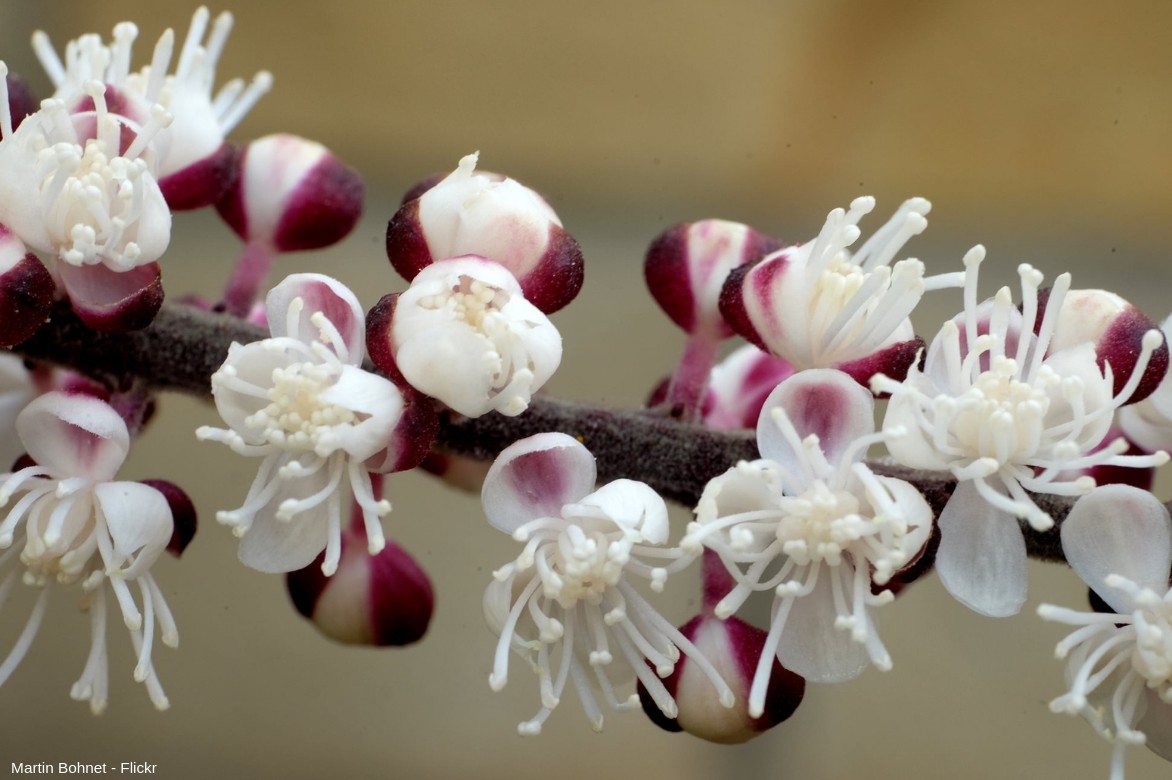
Main species and varieties of Cimicifuga

Actaea simplex Carbonella
- Flowering time October to December
- Height at maturity 90 cm

Cimicifuga Brunette
- Flowering time September to November
- Height at maturity 1,20 m

Cimicifuga simplex James Compton
- Flowering time October, November
- Height at maturity 90 cm

Cimicifuga japonica Cheju-Do
- Flowering time October, November
- Height at maturity 80 cm

Actaea pachypoda Misty Blue
- Flowering time June, July
- Height at maturity 60 cm

Cimicifuga White Pearl
- Flowering time November, December
- Height at maturity 1,20 m
Discover other Cimicifuga
View all →Available in 2 sizes
Available in 1 sizes
Available in 3 sizes
Available in 2 sizes
Available in 1 sizes
Available in 3 sizes
Available in 2 sizes
Available in 1 sizes
Available in 2 sizes
Available in 4 sizes
Planting
Where to plant cimicifugas?
Cimicifuga can be planted across metropolitan France provided its hardiness and light and soil requirements are respected. Hardy down to -15°C, it thrives in shade or partial shade. Avoid sunny spots to prevent foliage burn.
It prefers a clay, neutral soil that remains consistently moist and humus-bearing. It tolerates wet ground.
Wind is an enemy of Cimicifuga. It may damage or flatten its flowering stems. Therefore, plant in a sheltered spot.
It is possible to grow compact cimicifugas in pots. Indeed, Cimicifuga needs fairly deep soil and a pot may be insufficient for large-growing varieties. For cimicifugas in pots, summer watering and an annual addition of compost are essential.
When to plant cimicifugas?
Ideally, Cimicifugas are planted in spring between March and April but they also tolerate planting between October and November. Avoid planting during frosts or any spells of hot weather.
How to plant cimicifugas?
Plant cimicifugas at a density of 3 to 5 plants per square metre. Spacing between each plant should equal the plant’s spread at ripeness. Before planting, remember to immerse the rootball in water for 15 minutes.
- Dig a hole three times the size of the rootball.
- Mix 3 to 5 shovelfuls of compost or planting compost with the excavated soil.
- Fill half the hole with this mix.
- Water the soil well to settle it.
- Place the cimicifuga plant in the centre of the hole, aligned with ground level.
- Completely fill the hole with soil, making a basin around the plant.
- Firm the soil and water thoroughly.
- Mulch around the plant so the soil does not dry out too quickly.
Keep up watering during first years and reduce frequency gradually.
After 3 years, your cimicifuga will be well established and will offer its most spectacular flowering displays. It is preferable not to move it to encourage its spectacular flowering.
Read also : How to plant a cimicifuga in a pot?
Care
If the location of your bugbanes has been chosen correctly, maintenance will be simpler for this easy-to-maintain perennial.
As flowering progresses, deadhead faded flowers to encourage formation of new flowers. At end of flowering, leave last flowers and foliage to dry; simply prune entire dry clump when growth resumes in spring.
In spring, when growth resumes is the ideal time to add compost to feed the plant throughout the year.
In summer, it is advisable to maintain a mulch at the base of your bugbanes to keep soil cool and reduce watering. Watering is essential in the first years after planting. In subsequent years, only watering during prolonged dry spells is recommended.
If wind flattens flowering stems, stake them.
Easy to grow, cimicifugas are rarely affected by diseases and pests.
Multiplication: division
Silver candles are easily propagated by division of their rootstock in autumn or spring. Given slow growth of most silver candles, it is advisable to carry out division only when plant is well established and large enough. Generally, wait 5 to 7 years. Carry out division simply with a spade, favouring one end of the rootstock. Allow 3 years for first dense flowering.
It is also possible to propagate silver candles by sowing but we do not recommend this method given slow growth and slow establishment of this genus.
Uses and associations in the garden
Create a mid-shade autumn scene by pairing your bugbane with Cyclamen hederifolium, hostas, Japanese anemones or pink or blue autumn asters. The white to pink-tinged flowers of bugbane combine with green-to-purple foliage and with white, pink, violet or bluish flowers.
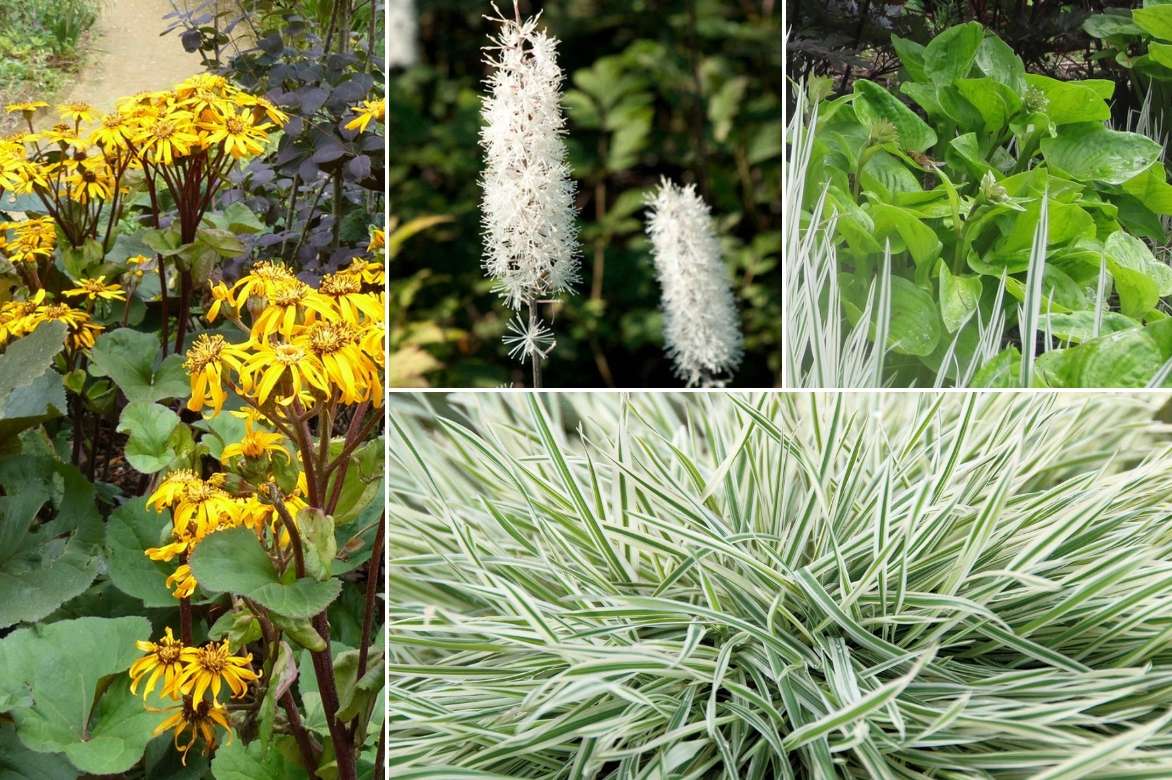
An example of a mid-shade combination: Ligularia dentata ‘Britt-Marie Crowford’, Cimicifuga simplex ‘Atropurpurea’, Hosta ‘Tattoo’ and Holcus mollis ‘Albovariegatus’
Alternatively, opt for a shade border in flower all year round. For spring flowering, favour epimediums, wood hyacinths, lamiums, forget-me-nots, Solomon’s seal and periwinkles. For summer flowering, rely on heucheras, hardy geraniums or alchemilla. And for the rest of the year, the foliage of ferns, helxine and sedges will be ideal to dress a cool shady corner.
Think about playing with the heights in your border, placing lower plants in front of bugbane. Position a dark background behind your bugbane to set off their pale flower spikes. To achieve this, plant shade trees or shrubs with dark foliage such as a conifer, holly, viburnum or euonymus.
Play with foliage contrasts: purple-leaved varieties of bugbane will marry perfectly with lime or pale-green foliage of heucheras or sedges.
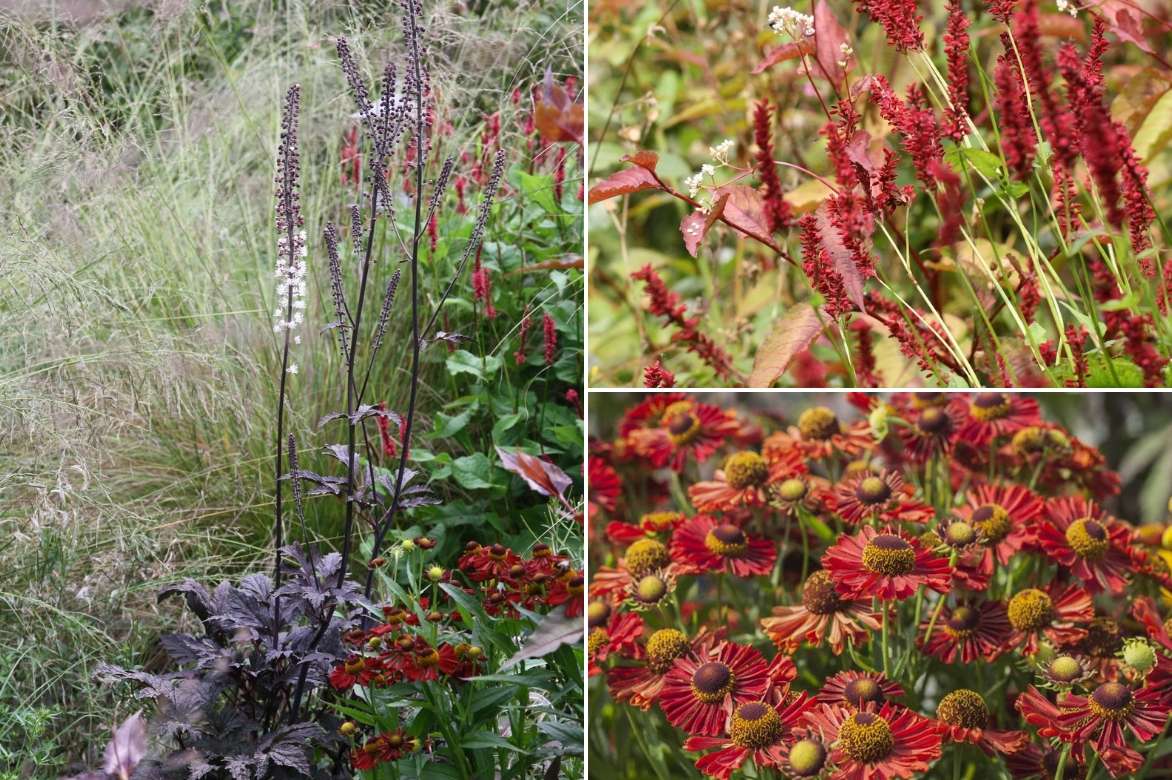
Another successful combination idea: Cimicifuga ‘James Campton’, Stipa gigantea in the background, Persicaria amplexicaulis ‘Blackfield’ or ‘Fat Domino’, for example, and Helenium ‘Ranchera’ or ‘Moerheim Beauty’
Did you know?
Cimicifugas are known for certain medicinal properties, notably that of the most common species, Cimicifuga racemosa. Roots and leaves of this species are reputed to help alleviate women’s health problems: painful periods, hot flushes and menopausal depression.
Useful resources
- Our complete collection of Cimicifuga
- All other shade-loving perennials in our catalogue
- Our video tips: Planting perennials
- Our advice sheet: How to create a beautiful perennial border?
- Advice sheet: 6 perennials for a north-facing garden
- Our selection of 7 superb varieties of Cimicifuga to discover
- Our ideas for pairing Cimicifuga with other shade plants
- Subscribe!
- Contents










































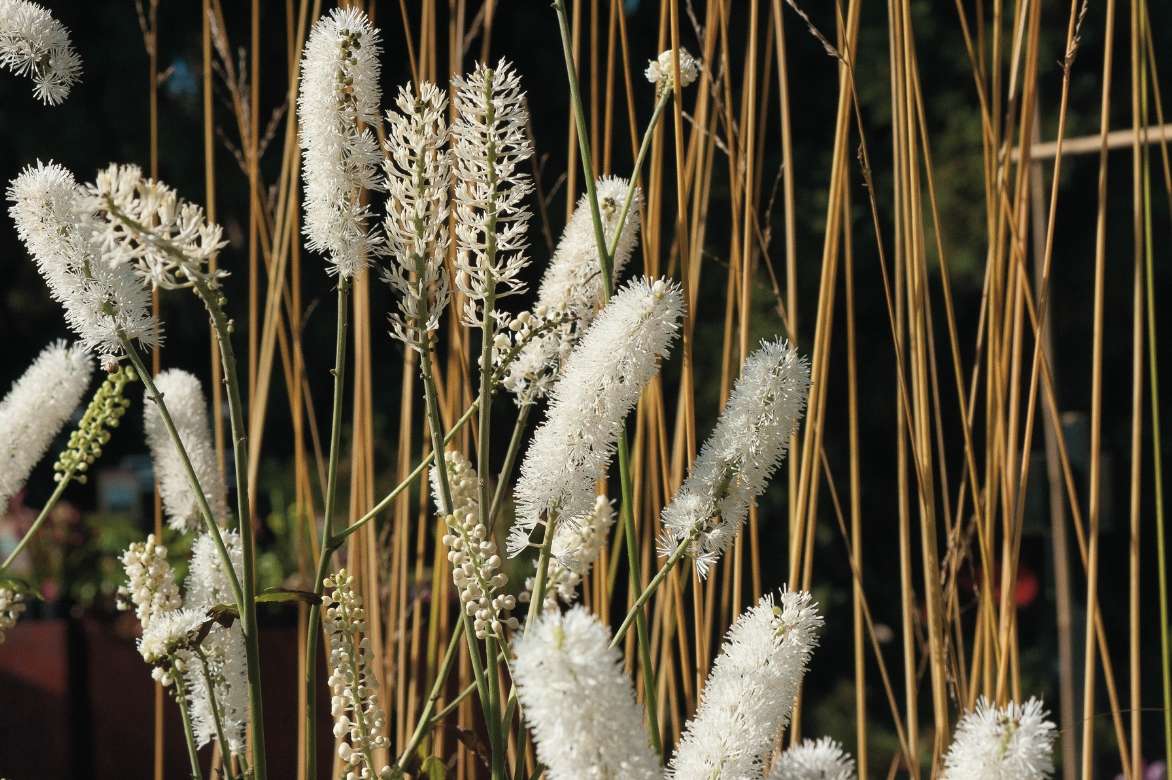
Comments